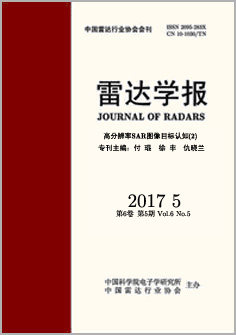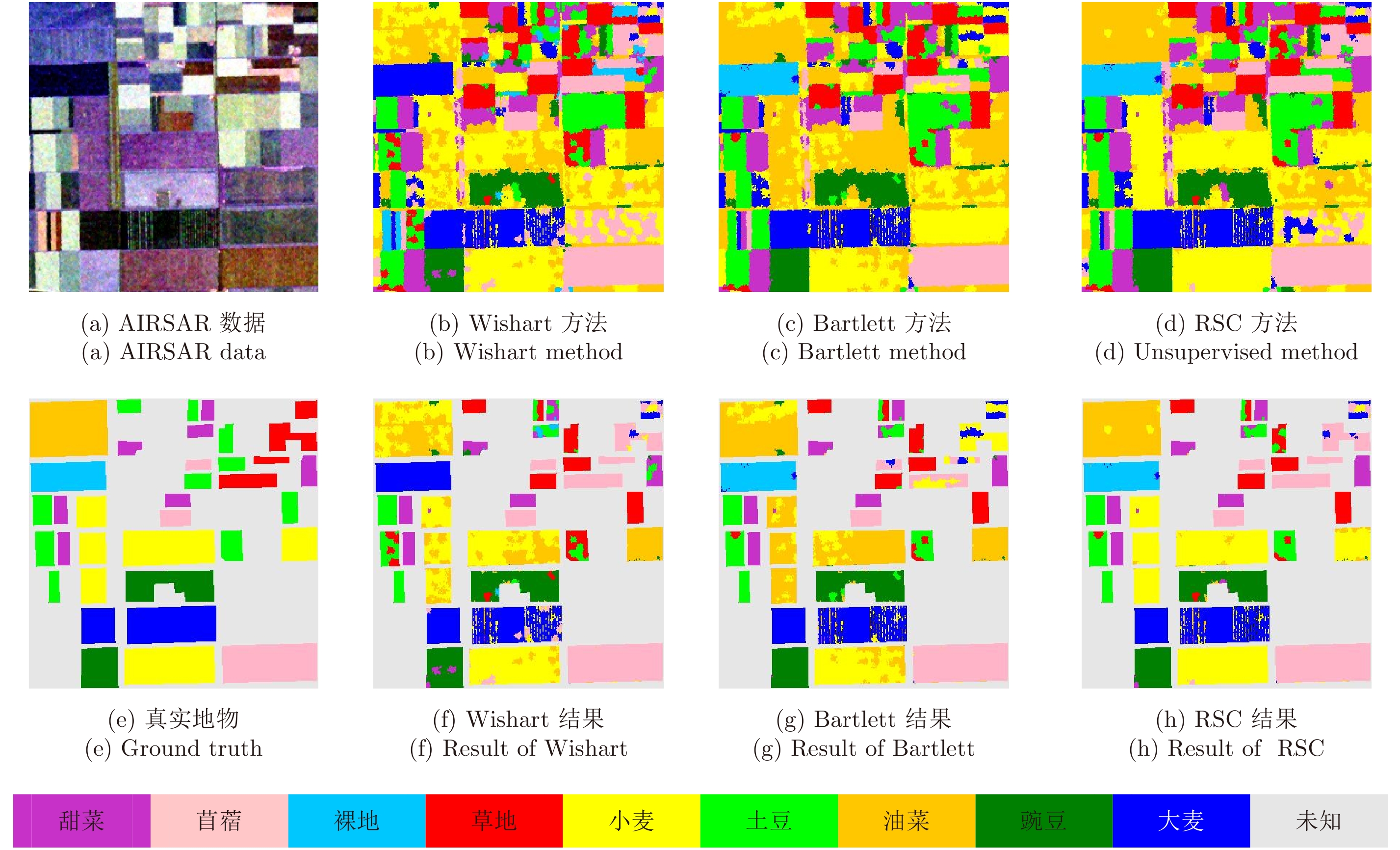| [1] |
Yang Wen, Song Hui, Xia Gui-song, et al.. Dissimilarity measurements for processing and analyzing PolSAR data: A survey[C]. Proceedings of 2015 IEEE International Geoscience and Remote Sensing Symposium (IGARSS), Milan, Italy, 2015: 1562–1565.
|
| [2] |
Lee J S, Grunes M R, Ainsworth T L, et al.. Unsupervised classification using polarimetric decomposition and the complex Wishart classifier[J]. IEEE Transactions on Geoscience and Remote Sensing, 1999, 37(5): 2249–2258. doi: 10.1109/36.789621 |
| [3] |
Frery A C, Correia A H, and Freitas C D C. Classifying multifrequency fully polarimetric imagery with multiple sources of statistical evidence and contextual information[J]. IEEE Transactions on Geoscience and Remote Sensing, 2007, 45(10): 3098–3109. doi: 10.1109/TGRS.2007.903828 |
| [4] |
Anfinsen S N, Jenssen R, and Eltoft T. Spectral clustering of polarimetric SAR data with the Wishart-derived distance measures[C/OL]. Proceedings of the 3rd International Workshop on Science and Applications of SAR Polarimetry and Polarimetric Interferometry, Noordwijk, Netherlands, 2007. http://adsabs.harvard.edu/abs/2007ESASP.644E..10A.
|
| [5] |
Banerjee A, Merugu S, Dhillon I S, et al.. Clustering with Bregman divergences[J]. The Journal of Machine Learning Research, 2005, 6: 1705–1749.
|
| [6] |
Kersten P R, Lee J S, and Ainsworth T L. Unsupervised classification of polarimetric synthetic aperture radar images using fuzzy clustering and EM clustering[J]. IEEE Transactions on Geoscience and Remote Sensing, 2005, 43(3): 519–527. doi: 10.1109/TGRS.2004.842108 |
| [7] |
Song H, Yang W, Bai Y, et al.. Unsupervised classification of polarimetric SAR imagery using large-scale spectral clustering with spatial constraints[J]. International Journal of Remote Sensing, 2015, 36(11): 2816–2830. doi: 10.1080/01431161.2015.1043759 |
| [8] |
Song Hui, Yang Wen, Xu Xin, et al.. Unsupervised PolSAR imagery classification based on Jensen-Bregman LogDet divergence[C]. Proceedings of the 10th European Conference on Synthetic Aperture Radar, Berlin, Germany, 2014: 1–4.
|
| [9] |
Cherian A, Sra S, Banerjee A, et al.. Jensen-Bregman LogDet divergence with application to efficient similarity search for covariance matrices[J]. IEEE Transactions on Pattern Analysis and Machine Intelligence, 2013, 35(9): 2161–2174. doi: 10.1109/TPAMI.2012.259 |
| [10] |
Zhang La-mei, Sun Liang-jie, Zou Bin, et al.. Fully polarimetric SAR image classification via sparse representation and polarimetric features[J]. IEEE Journal of Selected Topics in Applied Earth Observations and Remote Sensing, 2015, 8(8): 3923–3932. doi: 10.1109/JSTARS.2014.2359459 |
| [11] |
Harandi M T, Hartley R, Lovell B, et al.. Sparse coding on symmetric positive definite manifolds using Bregman divergences[J]. IEEE Transactions on Neural Networks and Learning Systems, 2016, 27(6): 1294–1306. doi: 10.1109/TNNLS.2014.2387383 |
| [12] |
Yang Fan, Gao Wei, Xu Bin, et al.. Multi-frequency polarimetric SAR classification based on Riemannian manifold and simultaneous sparse representation[J]. Remote Sensing, 2015, 7(7): 8469–8488. doi: 10.3390/rs70708469 |
| [13] |
Song Hui, Yang Wen, Zhong Neng, et al.. Unsupervised classification of PolSAR imagery via kernel sparse subspace clustering[J]. IEEE Geoscience and Remote Sensing Letters, 2016, 13(10): 1487–1491. doi: 10.1109/LGRS.2016.2593098 |
| [14] |
Cherian A and Sra S. Riemannian sparse coding for positive definite matrices[C]. Proceedings of European Conference on Computer Vision (ECCV), Zurich, Switzerland, 2014: 299–314.
|
| [15] |
Yang Wen, Zhong Neng, Yang Xiang-li, et al.. Riemannian sparse coding for classification of PolSAR images[C]. Proceedings of 2016 IEEE International Geoscience and Remote Sensing Symposium (IGARSS), Beijing, China, 2016: 5698–5701.
|
| [16] |
Pennec X, Fillard P, and Ayache N. A Riemannian framework for tensor computing[J]. International Journal of Computer Vision, 2006, 66(1): 41–66. doi: 10.1007/s11263-005-3222-z |
| [17] |
Arsigny V, Fillard P, Pennec X, et al.. Log-Euclidean metrics for fast and simple calculus on diffusion tensors[J]. Magnetic Resonance in Medicine, 2006, 56(2): 411–421. doi: 10.1002/(ISSN)1522-2594 |
| [18] |
Jayasumana S, Hartley R, Salzmann M, et al.. Kernel methods on Riemannian manifolds with Gaussian RBF kernels[J]. IEEE Transactions on Pattern Analysis and Machine Intelligence, 2015, 37(12): 2464–2477. doi: 10.1109/TPAMI.2015.2414422 |
| [19] |
Tibshirani R. Regression shrinkage and selection via the lasso: A retrospective[J]. Journal of the Royal Statistical Society, 2011, 73(3): 273–282. doi: 10.1111/rssb.2011.73.issue-3 |
| [20] |
Elhamifar E and Vidal R. Sparse subspace clustering: Algorithm, theory, and applications[J]. IEEE Transactions on Pattern Analysis and Machine Intelligence, 2013, 35(11): 2765–2781. doi: 10.1109/TPAMI.2013.57 |
| [21] |
Cherian A and Sra S. Riemannian dictionary learning and sparse coding for positive definite matrices[J]. IEEE Transactions on Neural Networks and Learning Systems, 2016. DOI: 10.1109/TNNLS.2016.2601307. |
| [22] |
Birgin E G, Martínez J M, and Raydan M. Algorithm 813: SPG-software for convex-constrained optimization[J]. ACM Transactions on Mathematical Software, 2001, 27(3): 340–349. doi: 10.1145/502800.502803 |
| [23] |
Wright J, Yang A Y, Ganesh A, et al.. Robust face recognition via sparse representation[J]. IEEE Transactions on Pattern Analysis and Machine Intelligence, 2009, 31(2): 210–227. doi: 10.1109/TPAMI.2008.79 |
| [24] |
Zhang Hong-yan, Li Jia-yi, Huang Yuan-cheng, et al.. A nonlocal weighted joint sparse representation classification method for hyperspectral imagery[J]. IEEE Journal of Selected Topics in Applied Earth Observations and Remote Sensing, 2014, 7(6): 2056–2065. doi: 10.1109/JSTARS.2013.2264720 |
| [25] |
Deledalle C A, Denis L, Poggi G, et al.. Exploiting patch similarity for SAR image processing: The nonlocal paradigm[J]. IEEE Signal Processing Magazine, 2014, 31(4): 69–78. doi: 10.1109/MSP.2014.2311305 |
| [26] |
Cheng Hong, Liu Zi-cheng, and Yang Jie. Sparsity induced similarity measure for label propagation[C]. Proceedings of the 2009 IEEE 12th International Conference on Computer Vision, Kyoto, Japan, 2009: 317–324.
|
| [27] |
Zelnik-Manor L and Perona P. Self-tuning spectral clustering[C]. Advances in Neural Information Processing Systems, Vancouver, 2004: 1601–1608.
|
| [28] |
Achanta R, Shaji A, Smith K, et al.. SLIC superpixels compared to state-of-the-art superpixel methods[J]. IEEE Transactions on Pattern Analysis and Machine Intelligence, 2012, 34(11): 2274–2282. doi: 10.1109/TPAMI.2012.120 |
| [29] |
Lee J S, Grunes M R, and Kwok R. Classification of multi-look polarimetric SAR imagery based on complex Wishart distribution[J]. International Journal of Remote Sensing, 1994, 15(11): 2299–2311. doi: 10.1080/01431169408954244 |
| [30] |
Foody G M. Status of land cover classification accuracy assessment[J]. Remote Sensing of Environment, 2002, 80(1): 185–201. doi: 10.1016/S0034-4257(01)00295-4 |
| [31] |
Cherian A, Morellas V, and Papanikolopoulos N. Bayesian nonparametric clustering for positive definite matrices[J]. IEEE Transactions on Pattern Analysis and Machine Intelligence, 2016, 38(5): 862–874. doi: 10.1109/TPAMI.2015.2456903 |
| [32] |
Xu Kan, Yang Wen, Liu Gang, et al.. Unsupervised satellite image classification using Markov field topic model[J]. IEEE Geoscience and Remote Sensing Letters, 2013, 10(1): 130–134. doi: 10.1109/LGRS.2012.2194770 |




 Submit Manuscript
Submit Manuscript Peer Review
Peer Review Editor Work
Editor Work





 DownLoad:
DownLoad:
